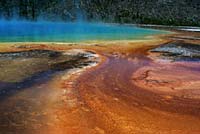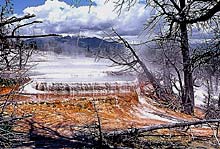The field of geobiology encourages
the investigation of the ways that life has shaped and been
shaped by its environment. Of particular interest are geological
processes that are affected or controlled by microbial activity.

Amongst
these processes, precipitation of calcium carbonate, stands
out as both a critically important geological process and one
to which microbial influence is frequently ascribed. Travertine
is a form of carbonate that is deposited when geothermally heated
subsurface waters, rich in CO2, emerge onto the surface and
rapidly precipitate calcium carbonate (CaCO3), in the form of
either calcite or aragonite (Ford & Pedley, 1996). Travertine
hot springs are excellent locations to study the interactions
between microbes and carbonate precipitation. The high temperatures
characteristic of travertine hot springs generally preclude
metazoan life. This is desirable from a geobiological perspective
for several reasons. First, from a purely practical perspective,
restricting the number of organisms in the environment makes
it easier to understand and model the interactions between organisms
and their environment. Secondly, geobiology is concerned with
interactions between organisms and their environment in the
ancient as well as the modern and the absence of multicellular
life in hot springs allows for observations and results made
in modern systems to be extrapolated into Archaean and Proterozoic
systems, before the evolution and widespread distribution of
metazoa. Further, it is widely believed based upon phylogenies
constructed from the genes encoding the 16S rRNA that life arose
around a hydrothermal system (Fouke et al., 2000). Examining
the microorganisms inhabiting hot springs today may provide
additional insight into the conditions surrounding the origin
and evolution of life. Finally, travertine hot springs typically
have mineral precipitation rates that can reach or exceed 1mm
per day (Ford & Pedley, 1996; Fouke et al., 2000). This generates
deposits of sufficient size for laboratory analysis within a
single field season.

We
will be examining the travertine system at Angel Terrace, part
of the Mammoth Hot Springs Complex in Yellowstone National Park,
WY. As part of our study, we will characterize the depositional
morphology of the travertine, both on the large terrace scale
(10-100m) and the individual terracette pools (0.1 - 5m) that
make up the system. In particular, we will examine the formation
of microbial mats (tentatively identified as
Phormidium
spp.) and their subsequent calcification into distinctive tufted
structures. These structures are analogous to the
Conophyton
stromatolites of the Archaean and Proterozoic. By examining
the environmental conditions in which these tufted mats occur
and the microbial consortia assorted with them, we may be able
to constrain the paleoenvironmental conditions at the time of
deposition of the
Conophyton stromatolites.
 Amongst
these processes, precipitation of calcium carbonate, stands
out as both a critically important geological process and one
to which microbial influence is frequently ascribed. Travertine
is a form of carbonate that is deposited when geothermally heated
subsurface waters, rich in CO2, emerge onto the surface and
rapidly precipitate calcium carbonate (CaCO3), in the form of
either calcite or aragonite (Ford & Pedley, 1996). Travertine
hot springs are excellent locations to study the interactions
between microbes and carbonate precipitation. The high temperatures
characteristic of travertine hot springs generally preclude
metazoan life. This is desirable from a geobiological perspective
for several reasons. First, from a purely practical perspective,
restricting the number of organisms in the environment makes
it easier to understand and model the interactions between organisms
and their environment. Secondly, geobiology is concerned with
interactions between organisms and their environment in the
ancient as well as the modern and the absence of multicellular
life in hot springs allows for observations and results made
in modern systems to be extrapolated into Archaean and Proterozoic
systems, before the evolution and widespread distribution of
metazoa. Further, it is widely believed based upon phylogenies
constructed from the genes encoding the 16S rRNA that life arose
around a hydrothermal system (Fouke et al., 2000). Examining
the microorganisms inhabiting hot springs today may provide
additional insight into the conditions surrounding the origin
and evolution of life. Finally, travertine hot springs typically
have mineral precipitation rates that can reach or exceed 1mm
per day (Ford & Pedley, 1996; Fouke et al., 2000). This generates
deposits of sufficient size for laboratory analysis within a
single field season.
Amongst
these processes, precipitation of calcium carbonate, stands
out as both a critically important geological process and one
to which microbial influence is frequently ascribed. Travertine
is a form of carbonate that is deposited when geothermally heated
subsurface waters, rich in CO2, emerge onto the surface and
rapidly precipitate calcium carbonate (CaCO3), in the form of
either calcite or aragonite (Ford & Pedley, 1996). Travertine
hot springs are excellent locations to study the interactions
between microbes and carbonate precipitation. The high temperatures
characteristic of travertine hot springs generally preclude
metazoan life. This is desirable from a geobiological perspective
for several reasons. First, from a purely practical perspective,
restricting the number of organisms in the environment makes
it easier to understand and model the interactions between organisms
and their environment. Secondly, geobiology is concerned with
interactions between organisms and their environment in the
ancient as well as the modern and the absence of multicellular
life in hot springs allows for observations and results made
in modern systems to be extrapolated into Archaean and Proterozoic
systems, before the evolution and widespread distribution of
metazoa. Further, it is widely believed based upon phylogenies
constructed from the genes encoding the 16S rRNA that life arose
around a hydrothermal system (Fouke et al., 2000). Examining
the microorganisms inhabiting hot springs today may provide
additional insight into the conditions surrounding the origin
and evolution of life. Finally, travertine hot springs typically
have mineral precipitation rates that can reach or exceed 1mm
per day (Ford & Pedley, 1996; Fouke et al., 2000). This generates
deposits of sufficient size for laboratory analysis within a
single field season. We
will be examining the travertine system at Angel Terrace, part
of the Mammoth Hot Springs Complex in Yellowstone National Park,
WY. As part of our study, we will characterize the depositional
morphology of the travertine, both on the large terrace scale
(10-100m) and the individual terracette pools (0.1 - 5m) that
make up the system. In particular, we will examine the formation
of microbial mats (tentatively identified as Phormidium
spp.) and their subsequent calcification into distinctive tufted
structures. These structures are analogous to the Conophyton
stromatolites of the Archaean and Proterozoic. By examining
the environmental conditions in which these tufted mats occur
and the microbial consortia assorted with them, we may be able
to constrain the paleoenvironmental conditions at the time of
deposition of the Conophyton stromatolites.
We
will be examining the travertine system at Angel Terrace, part
of the Mammoth Hot Springs Complex in Yellowstone National Park,
WY. As part of our study, we will characterize the depositional
morphology of the travertine, both on the large terrace scale
(10-100m) and the individual terracette pools (0.1 - 5m) that
make up the system. In particular, we will examine the formation
of microbial mats (tentatively identified as Phormidium
spp.) and their subsequent calcification into distinctive tufted
structures. These structures are analogous to the Conophyton
stromatolites of the Archaean and Proterozoic. By examining
the environmental conditions in which these tufted mats occur
and the microbial consortia assorted with them, we may be able
to constrain the paleoenvironmental conditions at the time of
deposition of the Conophyton stromatolites.
